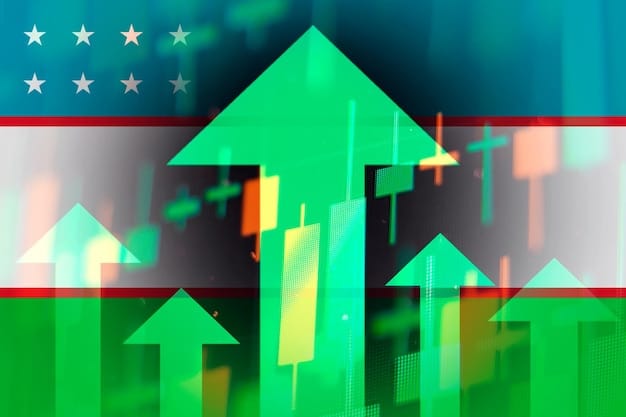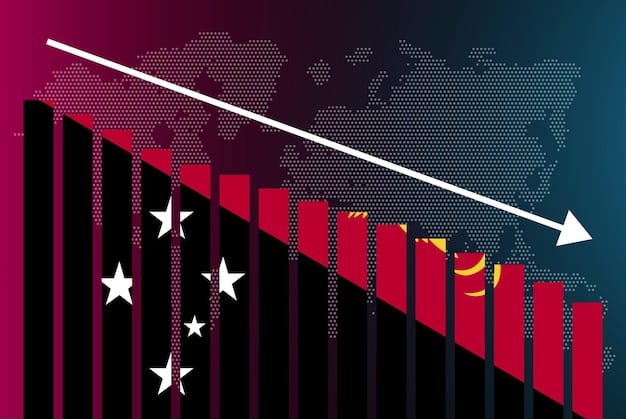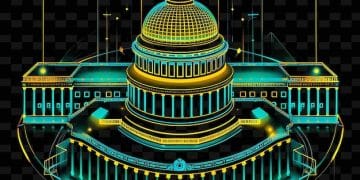Fed’s Policy Changes & US Inflation: A Deep Dive

The Federal Reserve’s proposed monetary policy changes could significantly impact US inflation by altering interest rates, affecting money supply and credit availability, and influencing market expectations, though the precise outcomes hinges on various economic factors and the Fed’s adaptable implementation.
Understanding how will the proposed changes to the Federal Reserve’s monetary policy affect inflation in the US? is a critical question for economists, policymakers, and everyday citizens alike. The Federal Reserve, often referred to as the Fed, wields considerable power in shaping the economic landscape through its monetary policy decisions. These decisions, though seemingly arcane to some, directly influence everything from the cost of borrowing a mortgage to the prices consumers pay for goods and services. As such, any proposed shifts in the Fed’s strategy warrant close examination to discern their potential inflationary consequences.
The Federal Reserve’s Mandate and Tools
The Federal Reserve operates under a dual mandate from Congress: to achieve maximum employment and maintain price stability. Price stability, in this context, broadly refers to keeping inflation at a healthy, consistent level, typically targeted at around 2%. To fulfill this mandate, the Fed employs several tools, each designed to influence the availability and cost of money and credit in the economy. Understanding these tools is fundamental before delving into how proposed changes might unfold.
Key Monetary Policy Instruments
The Fed’s toolkit is multifaceted, allowing it to fine-tune economic conditions. Interest rate adjustments, reserve requirements, and open market operations are the primary levers it pulls. Each instrument has a direct or indirect impact on the lending behavior of commercial banks and, consequently, on economic activity and inflation.
- Federal Funds Rate (FFR): This is perhaps the most widely recognized tool. The FFR is the target rate for overnight borrowing between banks. While the Fed does not directly control this rate, it influences it through open market operations. A lower FFR typically encourages lending, stimulating economic growth but potentially fueling inflation. Conversely, a higher FFR aims to curb inflation by making borrowing more expensive.
- Quantitative Easing (QE) and Tightening (QT): These involve the Fed buying (QE) or selling (QT) government bonds and other securities. QE injects liquidity into the financial system, lowering long-term interest rates and encouraging investment. QT, on the other hand, removes liquidity, which can lead to higher long-term rates and aims to cool an overheating economy.
- Reserve Requirements: Though less frequently adjusted now, these are the portions of customer deposits that banks must hold in reserve rather than lend out. Lowering requirements frees up more money for lending, potentially increasing the money supply and inflation.
The Fed’s communication strategy itself serves as a powerful tool. By signaling its intentions and economic outlook, the Fed can influence market expectations, which in turn can affect economic behavior even before official policy changes are enacted. This forward guidance is particularly crucial in times of uncertainty and can play a significant role in managing inflationary expectations.
Proposed Changes and Their Potential Mechanisms
While the specific “proposed changes” often refer to ongoing adjustments based on economic data, they can also encompass broader shifts in the Fed’s framework or approach. Historically, the Fed has adapted its strategies in response to evolving economic conditions and lessons learned. For instance, the move to an “average inflation targeting” framework in 2020 represented a significant shift. This new approach allows the Fed to let inflation run moderately above 2% for some time to compensate for periods when it ran below target, aiming for 2% on average over time. This particular change has direct implications for how inflation is perceived and managed.
Other potential changes might involve refinements to its balance sheet normalization process, adjustments to its liquidity facilities, or even innovations in its communication strategies. Each of these can influence inflation through different channels. For example, a more aggressive approach to quantitative tightening could reduce the money supply more rapidly, potentially having a more pronounced disinflationary effect. Conversely, a more patient approach to raising interest rates, especially in the face of persistent supply-side shocks, might lead to higher-for-longer inflation.

Impact on Money Supply and Credit
The core mechanism through which Fed policies affect inflation is their impact on the money supply and the cost of credit. When the Fed lowers interest rates or engages in quantitative easing, it effectively makes money cheaper and more abundant. This encourages businesses to borrow and invest, leading to job creation and increased demand for goods and services. While this stimulates economic growth, an excessive increase in the money supply relative to the production of goods and services can lead to “too much money chasing too few goods,” a classic definition of demand-pull inflation.
Conversely, hiking interest rates or embarking on quantitative tightening makes borrowing more expensive and reduces the money supply. This can cool down an overheated economy, reducing aggregate demand and thereby alleviating inflationary pressures. The interplay between these policy actions and their lagged effects on the broader economy makes forecasting precise inflationary outcomes particularly challenging.
Furthermore, the availability of credit affects consumer spending. When credit is cheap and easily accessible, consumers are more likely to make large purchases, such as homes and cars, or to finance everyday consumption. This contributes to overall demand in the economy. If the Fed’s proposed changes aim to tighten credit conditions, consumers may reduce their spending, which in turn can lead to a slowdown in price increases. The challenge for the Fed lies in calibrating these changes to achieve disinflation without triggering a significant economic downturn.
Market Expectations and Inflationary Psychology
Beyond the direct economic levers, the Federal Reserve’s actions profoundly influence market expectations and, crucially, inflationary psychology. If businesses and consumers anticipate higher inflation, they may adjust their behaviors accordingly, leading to a self-fulfilling prophecy. Workers might demand higher wages, and businesses might raise prices in anticipation of increased costs. This wage-price spiral can embed inflation into the economy, making it much harder to dislodge.
The Fed’s communication plays a vital role here. Clear and consistent forward guidance about its future policy path can anchor inflation expectations, even if current inflation is volatile. If the market believes the Fed is committed to its 2% inflation target and has the tools and resolve to achieve it, this can prevent runaway inflation expectations from taking hold. Conversely, any perceived ambiguity or indecision from the Fed can spook markets, leading to unanchored expectations and higher volatility in inflation.
Credibility and Policy Effectiveness
The credibility of the Federal Reserve is paramount to the effectiveness of its monetary policy. If the public no longer trusts the Fed’s ability or willingness to control inflation, then its policy tools become less potent. For instance, if the Fed signals an intention to raise interest rates to combat inflation, but market participants believe it will ultimately capitulate due to political pressure or fear of recession, then the expected impact on inflation will be diminished. Therefore, any proposed changes to policy must be communicated and implemented in a manner that reinforces the Fed’s commitment to its dual mandate, especially price stability.
This challenge is particularly acute when the economy faces supply-side shocks, such as those experienced during the pandemic and its aftermath. In such scenarios, traditional demand-management tools might not be sufficient, and aggressive rate hikes could exacerbate supply issues or trigger a recession. The Fed’s proposed adaptive strategies, therefore, often attempt to balance the need to curb inflation with the imperative to support economic growth and employment, a delicate act in a complex economic environment. The market constantly scrutinizes these strategic choices, assessing their feasibility and likely impact on future price levels.
Specific Scenarios and Outcomes
Let’s consider a few hypothetical scenarios for proposed changes and their potential inflationary impacts. Suppose the Fed decides to significantly accelerate its quantitative tightening program, selling off its bond holdings faster than previously anticipated. This would effectively drain liquidity from the financial system more quickly, leading to higher long-term interest rates. Businesses would find it more expensive to borrow for investment, and consumers would face higher loan rates for mortgages and car loans. This scenario would likely exert strong disinflationary pressure, potentially even risking deflation if overdone, by reducing aggregate demand. The goal would be to bring inflation down, but at the risk of slower economic growth or even a mild recession.
Another scenario might involve a recalibration of the Fed’s average inflation targeting framework, perhaps in response to persistently high inflation. If the Fed were to signal a stricter adherence to the 2% target, even tolerating a period of below-target inflation to compensate for recent overshoot, this would convey a strong anti-inflationary message. Such a change in forward guidance could help anchor inflation expectations downward, encouraging businesses to temper price increases and consumers to anticipate less future inflation. The market’s interpretation of such a shift would be key: if seen as credible, it could swiftly impact inflationary psychology.
Supply-Side Factors and Global Influences
It’s crucial to acknowledge that the Fed’s monetary policy operates within a broader economic context. Supply-side factors, such as disruptions in global supply chains, geopolitical events affecting energy prices, or labor market dynamics, can exert significant inflationary pressures independent of monetary policy. While the Fed can influence demand, its tools are less effective at directly addressing these supply-side issues. Proposed changes, therefore, often require a careful assessment of whether current inflation is primarily demand-driven or supply-driven.
Moreover, global economic conditions and central bank policies in other major economies can also spill over into US inflation. For example, if other major central banks are also tightening monetary policy, this can strengthen the dollar, making imports cheaper and potentially reducing imported inflation. Conversely, if global demand remains robust despite domestic tightening, it could limit the disinflationary impact of the Fed’s actions. Understanding these complex interdependencies is vital for any comprehensive analysis of the Fed’s policy changes.
The interconnectedness of financial markets means that changes in interest rates or liquidity in one major economy can ripple across the globe. For example, if the Fed adopts a more hawkish stance, it might attract capital flows to the US, strengthening the dollar. A stronger dollar makes US exports more expensive, potentially hurting domestic industries, but it also makes imports cheaper for US consumers, which can help to reduce inflationary pressures from imported goods. The net effect on inflation is a complex calculation, dependent on the relative magnitudes of these opposing forces.
Challenges and Unintended Consequences
Implementing monetary policy, especially amid economic uncertainty, is fraught with challenges and the potential for unintended consequences. The economy’s response to policy changes is often lagged and can be non-linear. For example, interest rate hikes take time to fully transmit through the economy, affecting borrowing costs, investment, and consumer spending with a delay of several quarters. This lag makes it difficult for the Fed to fine-tune its policies in real-time, risking either overshooting or undershooting its inflation targets.
One potential unintended consequence of aggressive tightening could be a severe economic slowdown or recession. If the Fed raises interest rates too quickly or too much, it could stifle investment, lead to widespread job losses, and trigger a contraction in economic activity. This “hard landing” scenario, while potentially bringing inflation down faster, carries significant social and economic costs. Conversely, if the Fed is too slow to react to inflationary pressures, it risks inflation becoming entrenched, requiring even more drastic and painful measures later on.
Another challenge lies in distinguishing between transient and persistent inflation. Some price increases might be temporary, caused by short-term supply disruptions or idiosyncratic events. Overreacting to these temporary spikes with aggressive policy tightening could unnecessarily harm the economy. The Fed must carefully analyze the underlying drivers of inflation to avoid policy errors. This requires robust economic data, sophisticated models, and experienced judgment, underscoring the expertise required at the highest levels of economic policymaking.
Distributional Impacts and Financial Stability
Monetary policy changes do not affect all segments of the population or the economy equally. For example, higher interest rates disproportionately impact borrowers, especially those with variable-rate loans or those looking to finance large purchases. Savers, conversely, might benefit from higher returns on their deposits. Understanding these distributional impacts is important for policymakers, even if they are not explicitly part of the Fed’s mandate.
There are also implications for financial stability. Rapid shifts in interest rates or liquidity can create stress in financial markets, potentially leading to instability. For example, if bond yields rise too sharply, it could create losses for institutions holding long-duration assets, or increase the risk of default for highly leveraged entities. The Fed must continuously monitor financial market conditions to ensure that its pursuit of price stability does not inadvertently jeopardize the broader financial system. Balancing these interconnected objectives is a continuous balancing act for the central bank.
Any proposed change to the Fed’s policy framework must be viewed through the lens of its potential on the housing market, for instance. Higher interest rates typically cool down the housing market by making mortgages more expensive, which can reduce demand and temper home price growth. While this might be a positive for inflation, it also impacts affordability and can slow construction activity, affecting employment in a key sector. The ripple effects across various sectors are complex and demand careful consideration.
The Path Forward: Adaptability and Data-Dependence
Given the complexities and myriad factors influencing inflation, the Federal Reserve’s approach to proposed policy changes is, and must be, highly adaptive and data-dependent. There is no single, static solution to managing inflation; instead, it is a continuous process of monitoring economic indicators, assessing the effectiveness of current policies, and adjusting course as necessary. This flexibility is crucial because economic conditions can evolve rapidly and unexpectedly.
The Fed regularly reviews its policy framework and tools, and ongoing scholarly research and public debate contribute to potential refinements. For example, discussions around the relative importance of different inflation measures, the role of climate change in economic stability, or the impact of technological advancements on productivity and pricing are all part of the evolving landscape that might inform future policy considerations. This iterative process of learning and adapting is essential for the Fed to remain effective in its dual mandate.
Ultimately, the question of how will the proposed changes to the Federal Reserve’s monetary policy affect inflation in the US? does not have a single, definitive answer. The outcome depends on the nature of the changes themselves, the prevailing economic conditions, the reaction of market participants, and the unpredictable interplay of domestic and global factors. The Fed’s commitment to transparency and its ability to clearly communicate its rationale for policy adjustments will be paramount in navigating these complexities and steering the US economy towards stable prices and maximum employment.
| Key Policy Impact | Brief Description |
|---|---|
| 🏦 Interest Rates | Changes in the Fed Funds Rate affect borrowing costs for consumers and businesses, influencing spending and investment. |
| 💸 Money Supply | Quantitative easing/tightening directly impacts the amount of money in circulation, affecting demand and prices. |
| 🧠 Expectations | The Fed’s communication shapes public and market inflation expectations, which can become self-fulfilling prophecies. |
| 🌍 Global Factors | International economic conditions and policies also influence US inflation, interacting with domestic Fed actions. |
Frequently Asked Questions About Fed Policy & Inflation
The Fed’s primary inflation objective is price stability, aiming for an average inflation rate of 2% over time, as part of its dual mandate alongside maximum employment. This target helps guide its monetary policy decisions.
Interest rate hikes make borrowing more expensive for consumers and businesses, which reduces demand for goods and services. Lower demand typically leads to slower price increases, helping to cool down an overheated economy and curb inflation.
Quantitative tightening (QT) involves the Fed selling off its bond holdings, which removes money from the financial system. This reduces liquidity, raises long-term interest rates, and aims to curb inflation by slowing economic activity and demand.
No, the Fed cannot fully control inflation alone. While its monetary policy significantly influences demand-side inflation, supply-side shocks (like energy price surges or supply chain disruptions) and global economic conditions also play crucial roles beyond its direct control.
Market expectations are crucial because if businesses and consumers anticipate higher inflation, they may raise prices or demand higher wages, creating a self-fulfilling spiral. The Fed’s communication aims to anchor these expectations around its 2% target.
Conclusion
The intricate dance between the Federal Reserve’s monetary policy and US inflation is a complex and highly dynamic process. Any proposed changes, whether subtle recalibrations or fundamental shifts in strategy, carry significant implications for the economic stability and purchasing power of American citizens. The Fed’s commitment to its dual mandate, its effective use of various policy tools, and its transparent communication are all critical factors in shaping the inflationary trajectory. While challenges such as supply-side shocks and an interconnected global economy remain, the Fed’s adaptive and data-dependent approach aims to navigate these complexities, striving for sustained price stability while fostering maximum employment.
Total words: 2289





